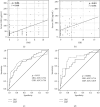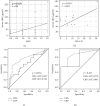Evaluation of Serum Leucine-Rich Alpha-2 Glycoprotein as a New Inflammatory Biomarker of Inflammatory Bowel Disease
- PMID: 33623482
- PMCID: PMC7874844
- DOI: 10.1155/2021/8825374
Evaluation of Serum Leucine-Rich Alpha-2 Glycoprotein as a New Inflammatory Biomarker of Inflammatory Bowel Disease
Abstract
Studies on serum leucine-rich alpha-2 glycoprotein (LRG) in inflammatory bowel disease (IBD), including ulcerative colitis (UC) and Crohn's disease (CD), are scarce; the methods for estimating disease activity are less established, particularly for CD. This study is aimed at evaluating the utility of serum LRG as a potential inflammatory marker for IBD and to investigate the LRG gene expression in peripheral blood mononuclear cells (PBMCs) as a possible source of serum LRG. Overall, 98 patients with UC and 96 patients with CD were prospectively enrolled and clinically evaluated; 92 age-matched individuals served as the healthy controls. The blood samples were analyzed for serum LRG levels and routine laboratory parameters. Disease activity was assessed clinically and endoscopically. Finally, LRG gene expression in the PBMCs from a different cohort (41 patients with UC, 34 patients with CD, and 30 healthy controls) was examined. The serum LRG levels were higher during active disease than during inactive disease; additionally, serum LRG levels were positively correlated with clinical disease activity, C-reactive protein (CRP) levels, and other laboratory parameters in patients with UC and CD and with endoscopic disease activity in UC. UC and CD showed comparable areas under the curve (AUC) values for determining clinical remission and differentiating between endoscopic remission associated with LRG and CRP. The levels of LRG mRNA were also increased in PBMCs from patients with UC and CD and reflected disease activity. These data suggest that serum LRG, originated partially from PBMCs, is an inflammatory marker in UC and CD. A large-scale well-designed study should be conducted in the future to more accurately reveal the clinical significance of LRG in patients with IBD.
Copyright © 2021 Tetsuhiro Yoshimura et al.
Conflict of interest statement
The authors declare that there is no conflict of interest regarding the publication of this paper.
Figures






References
MeSH terms
Substances
LinkOut - more resources
Full Text Sources
Other Literature Sources
Research Materials
Miscellaneous

